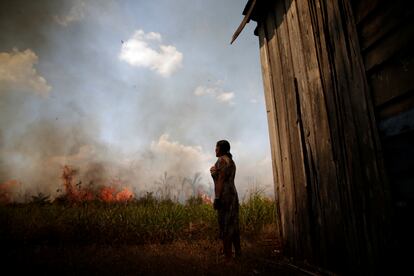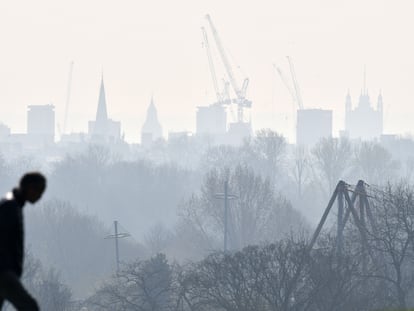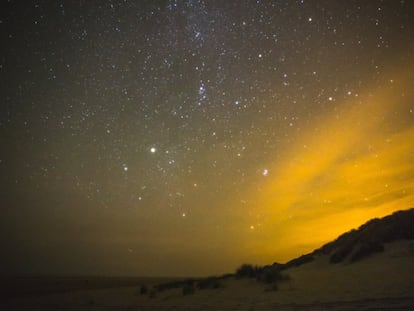Pioneering study measures ravages of forest fires, identifying 230 Indigenous victims over the course of five years in the Amazon
For the first time, a report quantifies how smoke from Amazon rainforest fires affects vulnerable groups, as they are more likely to be exposed to polluting particles


One day, in 2019, the Brazilian city of São Paulo went dark. Night hadn’t fallen; rather, particles from the fires in the Amazon rainforest had travelled to the heavily-populated city, turning everything gray. This episode, which raised many questions about the impact that fires have on public health, was engraved in the memory of Dr. Eimy Bonilla, a researcher in Environmental Sciences and Engineering at Harvard University.
“There was already a lot of evidence [and] scientific articles that talked about how big cities were affected by this smoke,” Bonilla explains. Since she had already been looking at the fires in the Amazon, she also wanted to understand how this phenomenon was affecting the health of the local Indigenous people. “What happens to the people who are close to these fires and whose information is not in the medical records, since many don’t have access to the system?” she asked herself at the time.
She subsequently zeroed in on the PM2.5 particles, which were left behind by the smoke from the fires as it moved through the air. These particles are so fine that they only reach 2.5 micrometers in diameter — 20 times smaller than the width of a hair. They enter the lungs faster, avoiding the various barriers that the body has to protect us. Exposure to these particles is related to premature deaths and respiratory diseases. PM2.5 particles have also been associated with cardiovascular problems, cancer, metabolic dysfunctions, mental health problems and health-related absences from work.
Through a model that examines how air travels through the atmosphere — when there are and when there aren’t fires — combined with demographic information from the Amazon basin and a formula about the impact of PM2.5 particles on premature deaths, Bonilla and her team concluded that those most at-risk populations are the Indigenous communities of the Amazon. Between 2014 and 2019 — the period they analyzed — there were around 12,000 premature deaths related to fire each year throughout South America. However, the figure just for those who are living in Indigenous territory was around 230 premature deaths.
Bonilla emphasizes the significance of this: while exposure to smoke is responsible for two premature deaths per 100,000 people throughout South America, in Indigenous territories, this figure increases to four deaths per 100,000 people. Essentially, it doubles. “This is a big problem, because, as we know, they are very small populations, but they’re highly affected. It’s worrisome,” the expert notes. She is co-author of the recent study published in Environmental Research: Health.
Viewed by country, the conclusions also vary. The research clarifies that, in Brazil, Argentina and Colombia, the greatest excess mortality rates related to smoke are among the urban populations. In Peru and Bolivia, on the other hand, there are more premature deaths related to this problem among Indigenous communities. To give another example, the data suggests that, between 2014 and 2019, exposure to smoke from forest fires represented almost 39,000 deaths throughout Brazil. And, just looking at the Indigenous territories of Peru, there were nearly 500 premature deaths.
The situation will become even more troubling if the current trend continues, with more fires fueled by human activities, such as mining, logging and agriculture. And this isn’t even taking into account the fact that climate change and rising temperature are making fires more likely. The study also says that, since 2002, the annual number of fires in the Amazon has twice exceeded the figure of 600,000, both in 2004 and 2007. While the overall number of figures decreased between 2004 and 2013 (falling to 264,000 fires per year), it shot up again to nearly 500,000 in 2020. When these fires turn large cities gray, it means that, well before they arrived in the urban areas, they darkened the neighboring towns and villages where they arose in the first place.
Sign up for our weekly newsletter to get more English-language news coverage from EL PAÍS USA Edition
Tu suscripción se está usando en otro dispositivo
¿Quieres añadir otro usuario a tu suscripción?
Si continúas leyendo en este dispositivo, no se podrá leer en el otro.
FlechaTu suscripción se está usando en otro dispositivo y solo puedes acceder a EL PAÍS desde un dispositivo a la vez.
Si quieres compartir tu cuenta, cambia tu suscripción a la modalidad Premium, así podrás añadir otro usuario. Cada uno accederá con su propia cuenta de email, lo que os permitirá personalizar vuestra experiencia en EL PAÍS.
¿Tienes una suscripción de empresa? Accede aquí para contratar más cuentas.
En el caso de no saber quién está usando tu cuenta, te recomendamos cambiar tu contraseña aquí.
Si decides continuar compartiendo tu cuenta, este mensaje se mostrará en tu dispositivo y en el de la otra persona que está usando tu cuenta de forma indefinida, afectando a tu experiencia de lectura. Puedes consultar aquí los términos y condiciones de la suscripción digital.
More information
Últimas noticias
Trump claims peace in Ukraine is near, but Moscow suggests otherwise
A survivor’s account of the Interoceanic Train accident: ‘We were scared because of the speed on the curve’
The Interoceanic Train, the Mexican alternative to the Panama Canal
What is known about the Interoceanic Train derailment in Oaxaca
Most viewed
- Oona Chaplin: ‘I told James Cameron that I was living in a treehouse and starting a permaculture project with a friend’
- Reinhard Genzel, Nobel laureate in physics: ‘One-minute videos will never give you the truth’
- Why the price of coffee has skyrocketed: from Brazilian plantations to specialty coffee houses
- Pablo Escobar’s hippos: A serious environmental problem, 40 years on
- Chevy Chase, the beloved comedian who was a monster off camera: ‘Not everyone hated him, just the people who’ve worked with him’










































